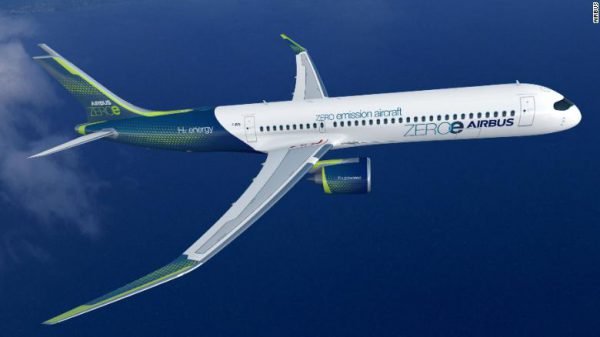In a big step towards decarbonisation of the entire aviation industry and towards becoming carbon-neutral, Airbus recently revealed several concepts for the world’s first zero-emission commercial aircraft. The aircrafts will be put into service by 2035.
Headquartered in the Netherlands, Airbus released three concepts, codenamed ZEROe, that explore various approaches to achieving a zero-emission flight but are dependent on hydrogen as the primary source of power to fly aircrafts. The organization estimates that the use of hydrogen has the promise of reducing the aviation industry’s carbon emissions by up to 50%.
The first concept features a turbofan design that would be powered by a modified gas-turbine engine running on hydrogen, rather than jet fuel, through combustion. It can carry between 120 and 200 passengers with a range of over 2,000 nautical miles.
The second concept features a turboprop design that would be powered by hydrogen combustion in modified gas-turbine engines and can be used for short-haul trips. This can carry up to 100 passengers and would be capable of traveling more than 1,000 nautical miles.
The third concept features a blended-wing body concept in which the wings merge with the main body of the aircraft with a range similar to that of the turbofan concept. This can carry up to 200 passengers with a range of 1,000 nautical miles.
So excited to have shared our #zeroe concept aircraft with you!
Missed it? We’ve got you covered. Check this out ?But this is only the beginning. Stay tuned for more in the weeks to come!
Learn more on our website: https://t.co/rl1CcXfsiK#ZeDay #ZeroEmissionsDay pic.twitter.com/iAMkofvz9e— Airbus (@Airbus) September 21, 2020
“This is a historic moment for the commercial aviation sector as a whole and we intend to play a leading role in the most important transition this industry has ever seen. The concepts we unveil today offer the world a glimpse of our ambition to drive a bold vision for the future of zero-emission flight,” said Guillaume Faury, Airbus CEO. “I strongly believe that the use of hydrogen – both in synthetic fuels and as a primary power source for commercial aircraft – has the potential to significantly reduce aviation’s climate impact.”
According to Faury, this transition to hydrogen as a fuel would require deliberate and decisive action from all stakeholders of the aviation industry. For instance, airports will need considerable hydrogen transport and refueling infrastructure to meet the needs of day-to-day operations. Also, the government will play a primary role in terms of providing increased funding for research and technology that goes into encouraging sustainable fuels.
The European Union aims to become the world’s first carbon-neutral region by 2050 and it has made hydrogen the foundation of its strategy to reach this goal.
This step by Airbus is a significant initiative by Airbus to reduce the direct emissions from aviation, which account for about three per cent of the European Union’s total greenhouse gas emissions.
Do let us know your views on these new concepts in the comments section below.
0